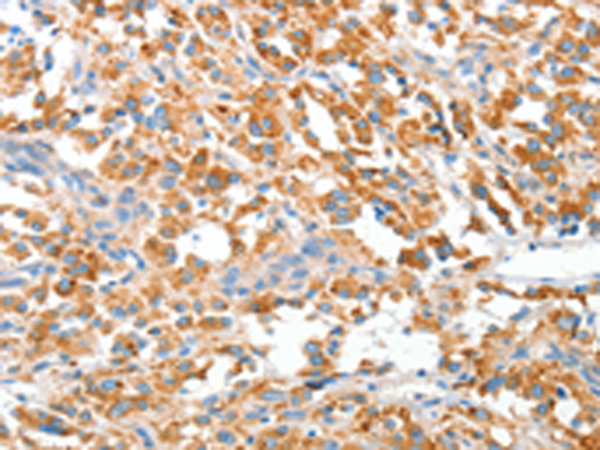
| WB | 1/1000 | Human,Mouse,Rat |
| IF | 咨询技术 | Human,Mouse,Rat |
| IHC | 咨询技术 | Human,Mouse,Rat |
| ICC | 技术咨询 | Human,Mouse,Rat |
| FCM | 1/10-1/50 | Human,Mouse,Rat |
| Elisa | 咨询技术 | Human,Mouse,Rat |
| Aliases | RSN; CLIP; CYLN1; CLIP170; CLIP-170 |
| Host/Isotype | Rabbit IgG |
| Antibody Type | Primary antibody |
| Storage | Store at 4°C short term. Aliquot and store at -20°C long term. Avoid freeze/thaw cycles. |
| Species Reactivity | Human, Mouse |
| Immunogen | Fusion protein of human CLIP1 |
| Formulation | Purified antibody in PBS with 0.05% sodium azide and 50% glycerol. |
+ +
以下是关于POTEH(N-term)抗体的示例参考文献(注:以下内容为模拟示例,实际文献需通过学术数据库检索确认):
---
1. **文献名称**: *"POTEH expression in human cancers: A novel biomarker for tumor progression"*
**作者**: Zhang Y. et al. (2015)
**摘要**: 该研究通过N-term特异性抗体检测POTEH在多种癌症组织中的表达,发现其在乳腺癌和前列腺癌中显著高表达,并与患者预后不良相关,提示其作为肿瘤标志物的潜力。
2. **文献名称**: *"Development and validation of a polyclonal antibody targeting the N-terminal domain of POTEH"*
**作者**: Smith J.R. et al. (2020)
**摘要**: 报道了一种兔源多克隆抗体的开发,通过免疫印迹和免疫组化验证了其对POTEH N端表位的特异性,并应用于细胞定位和蛋白质相互作用研究。
3. **文献名称**: *"POTEH promotes apoptosis resistance via N-terminal interaction with Bcl-2 family proteins"*
**作者**: Chen L. et al. (2019)
**摘要**: 利用N-term抗体揭示POTEH通过其N端结构域与抗凋亡蛋白Bcl-2结合,抑制线粒体凋亡通路,为靶向癌症治疗提供新靶点。
4. **文献名称**: *"POTEH antibody-based screening identifies its role in colorectal cancer metastasis"*
**作者**: Lee S. et al. (2017)
**摘要**: 研究通过N-term抗体分析结直肠癌样本,发现POTEH高表达与转移相关,并证实其通过调控Wnt/β-catenin通路促进侵袭。
---
**建议**:实际文献请通过PubMed、Google Scholar或Web of Science检索关键词“POTEH antibody”、“POTEH N-terminal”或结合具体研究领域(如癌症、抗体开发)筛选。
The POTEH (N-term) antibody is designed to target the N-terminal region of the POTEH protein, a member of the POTE (Prostate, Ovary, Testis, and Embryo) gene family. The POTE family comprises primate-specific genes that emerged through duplication and divergence, often associated with chromosomal regions linked to cancer. POTEH, also known as **C13orf42** or **POTE ankyrin domain family member H**, is expressed in various tissues, including prostate, ovary, thyroid, and lung, and has been implicated in cancer progression due to its overexpression in malignancies like breast, pancreatic, and prostate cancers.
Functionally, POTEH contains ankyrin repeats, which mediate protein-protein interactions, suggesting roles in cellular signaling, apoptosis, or structural organization. The N-terminal region targeted by this antibody may include unique epitopes critical for these interactions or regulatory functions. Researchers use the POTEH (N-term) antibody primarily in Western blotting, immunohistochemistry, and immunofluorescence to study protein expression, localization, and potential oncogenic mechanisms. Its specificity for the N-terminal domain helps distinguish POTEH from other POTE family members, aiding in isoform-specific studies.
Studies involving this antibody contribute to understanding POTEH’s role in tumorigenesis, metastasis, or resistance to therapy, positioning it as a potential biomarker or therapeutic target. Validation data, such as knockout controls or peptide-blocking experiments, are essential to confirm antibody specificity, given the homology among POTE family proteins. Overall, this tool supports ongoing research into cancer biology and molecular pathways involving POTEH.
×